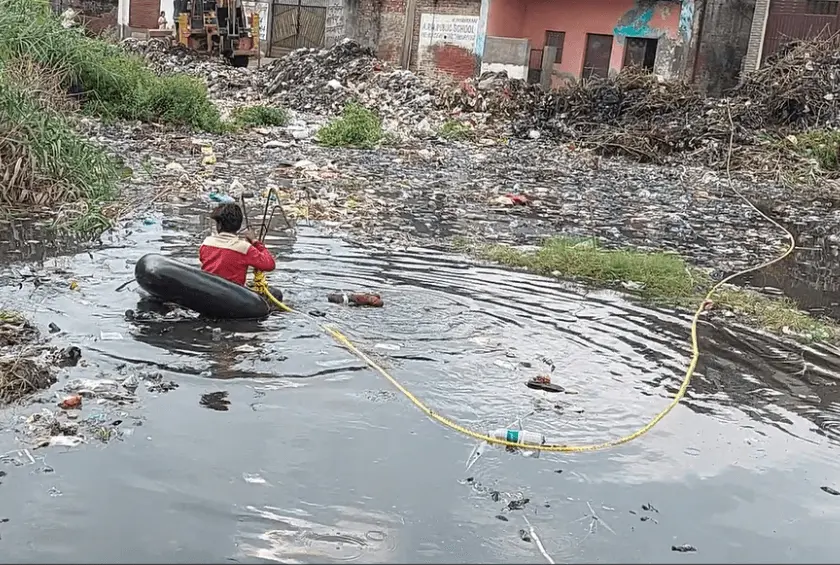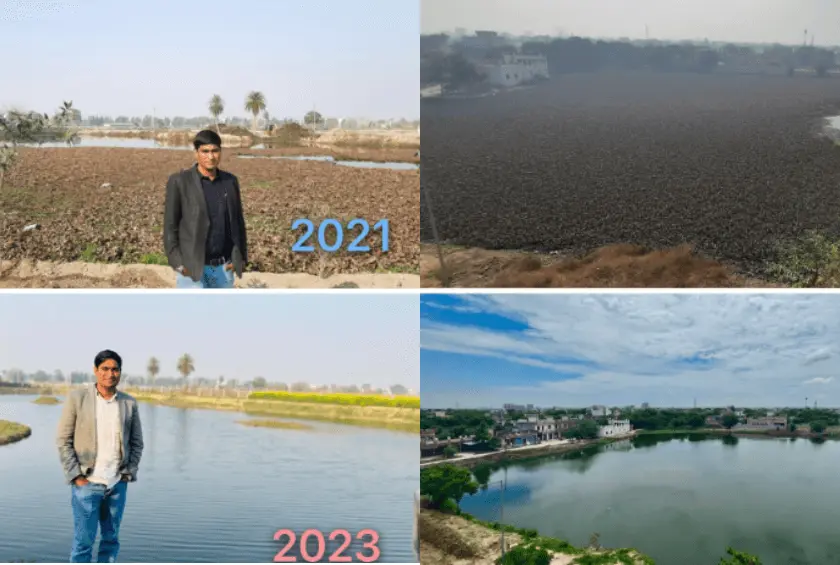

- 15 Jun 2023

Some problems never seem like problems until they start affecting us personally. So is the problem of water pollution and conservation all around the world. The possibility of water running out on earth someday is still a hoax for many, which results in misuse and careless usage.
I grew up in a village named Dadha in Uttar Pradesh, where most of the families, including us, depended on farming. I recall that buffalo rearing was a common occupation there, and growing up, grazing buffaloes in the forest nearby was my routine. The pond in my village was where I learned to swim, and that remains one of the core memories of my childhood. Growing up close to nature made me grateful and respectful of what it provides, and it is one of the reasons we have now saved over 3000 million liters of water.
I am the only sibling out of five who had the opportunity to graduate in my family. Soon after I passed 12th grade, I started teaching physics and math to the children in my village. Since we were all students, we would end up discussing a lot outside of physics and math.
During one such discussion, the topic at hand was how practical our syllabus is in our day-to-day lives. The main motive of our education is to achieve academic excellence, regardless of whether we practice what we learn or not. One of my students pointed out that Environmental Studies (EVS) emphasizes restoration, but that information is restricted to theory and not often put to practice. We wanted to change that, starting at home.
Upon crunching a few numbers, we were surprised to know that we were wasting thousands of liters of water as a small village while simply washing our buffaloes with pipes. A logical solution was to encourage people to switch to buckets instead of pipes to wash their buffaloes, that’s where we started.
Posters were made, and rallies were conducted to raise awareness about the risk of water wastage in the hope that people would join us. We started Sunday meetings to discuss possible collective efforts for a bigger change. Although some people joined us, we also faced major reluctance from parents who wanted their children to focus on their studies instead of attending to issues like these.
I had almost given up on this venture when our district collector recognized and appreciated our effort to save water. There was no going back then. The rallies, which later were called ‘Jal Chaupal’, resumed once every two months, and as we reached more people in and around my village, more volunteers joined our cause.
While juggling college, tuition, and Jal Chaupal for months, I finally graduated and was now working a 5 a.m. to 2 p.m. job because I was clear that no matter what, I would not give up on my dream. But there was still a void. We were spreading awareness, but there hadn't been any practical measures taken yet, and the need to set an example of change laid the foundation for our pond restoration initiative.
When I decided to start a pond clean-up and restoration drive in my village, I hadn’t expected the challenges it would bring forth. The pond in our village was propertied by the villagers, with merely 20% of the pond left for us to work on. In hopes of securing support from the Sub-Division Magistrate (SDM), I pitched my proposal, in response to which the SDM decided to access the entire pond first.
The word spread like wildfire, and I was instantly held accountable for trying to unhouse the villagers. This single proposal put my familyand I in misery when a panchayat was held, and I was declared a traitor. This incident led me to retract my proposal and pause my initiative for a good six months.

I eventually figured that I needed to find a pond that could be cleaned and restored independently. A pond in the neighboring village became our first pond restoration site,where I, along with my students, their parents, and other volunteers, not only cleaned the pond premises but also planted trees around it to promote a healthier ecosystem. Our initiative received great appreciation from people and the government wanted to support it. A restoration drive, which would normally be quoted at around INR 30 lakh, was executed for just INR 2 lakh with elevated efficiency.
Eventually, I went on to work with the government as a consultant and further decided to quit my job to pursue my pond restoration project independently in 2018. With the help of different courses and seminars, I learned about the diverse possibilities that CSR initiatives hold for causes. I dedicated the next two years of my life to learning how NGOs partnered with corporate companies, and finally, in 2020, I was able to register my NGO called Say Earth.
A loophole that I found while working with different firms was that the many pond restoration drives weren’t self-sustainable and required regular restoration, which was neither efficient nor affordable. Hence, we came up with unique measures for self-sustenance, which to this day work wonders for our pond restoration projects.
We integrated ponds with fish farming, with the condition of raising at least 10,000 slush-eating fish that would keep the water clean. Some are equipped with eco-tourism, and some with water chestnut and even vegetable farming. The idea was to earn enough costs to maintain these ponds and it worked! We also created pits around ponds to collect garbage to avoid any further pollution.
An important part of Say Earth is reaching the maximum number of people so that its impact is maximized nationally. What better way to connect with people than social media? A #selfiewithpond initiative was launched to connect people, especially youth, with the severity of the situation and how their efforts can make a difference. To our surprise, we got over 10,000 supporters from this one initiative, and the reason was heartbreaking. People who had left their hometowns for employment opportunities in bigger cities came back to a wretched home with trees cut down and ponds turned into landfills. The initiative gave me the community I was looking for.

In October 2021, the Prime Minister addressed me as the Pond Man on a national platform in his Mann Ki Baat programme. Since then, I have been invited for various speeches by colleges and recently had the opportunity to reach a bigger audience through Ted Talk. To date, we have restored over 80 ponds in India and saved approximately 3000 million liters of water. Our recent work in Kotwalpur is going to elevate the ecosystem of the region with a pond holding 87 lakh liters of water. I still work as a consultant and supervisor with various institutions. I am also a brand ambassador for the Ghaziabad Municipal Corporation and the coordinator for my own district.
I started this initiative with the goal of finding my childhood while restoring ponds, but eventually, I realized that we need ponds more than they need us. Pond restoration projects need to be more focused on biodiversity and less on commercialization. Environmental resources are limited, and considering the dire conditions the world is in, saving and restoring is the only way to provide future generations with a childhood like the one we had, far from the plastic nightmare we’re headed towards!
Exclusively written for Giving for Good Foundation by Bhairavi Hiremath

With words as her medium and a diary full of scribbled ideas, she is usually found looking for ways to use her writing to impact for Good. If she’s out of sight, she’s probably either reading, petting cats, jamming to retro Bollywood, or of course, writing!